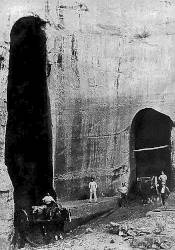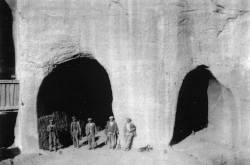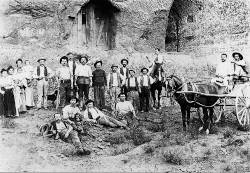Mines de Bruoux
Carrière d’Ocre de Gargas
Useful Information



| Location: |
Gargas.
(43.9079890791134, 5.345497940189845) |
| Open: |
MAY to OCT daily 10-18. Tours: MAY to 11-JUL 10:30, 11:30, 14:30, 15:30, 16:30. 12-JUL to 27-AUG 10:30, 11:00, 11:30, 14:00, 14:30, 15:00, 15:30, 16:00, 16:30, 17:00. 28-AUG to OCT 10:30, 11:30, 14:30, 15:30, 16:30. Reservation mandatory, arrive 20 min earlier. [2021] |
| Fee: |
Adults EUR 9.50, Children (6-11) EUR 6.50, Children (3-5) EUR 3.50, Children (0-3) free, Students (-22) EUR 8.50, Disabled EUR 8.50, Unemployed EUR 8.50. Family from the 3rd child EUR 3.50. Groups: Adults EUR 8.50, School Pupils EUR 7.50, Low Season EUR 3.50. [2021] |
| Classification: |
 Sand Mine Sand Mine
 Eluvial Deposit Eluvial Deposit
|
| Light: | n/a |
| Dimension: | L=40 km, T=10 °C. |
| Guided tours: |
L=650 m, D=60 min, Max=30. Audioguide 



 V=32,380/a [2019]
V=32,380/a [2019]
|
| Photography: | forbidden |
| Accessibility: | yes |
| Bibliography: | |
| Address: |
Mines de Bruoux, 1434 Route de Croagnes, 84400 Gargas, Tel: +33-490-06-22-59.
E-mail: |
| As far as we know this information was accurate when it was published (see years in brackets), but may have changed since then. Please check rates and details directly with the companies in question if you need more recent info. |
|
History
| 1785 | Jean-Etienne Astier discovered a way to extract the ore and started exploitation in Roussillon. |
| 1848 | beginning of ochre mining at Gargas. |
| 1950s | mines closed due to cheaper chemical piments. |
| 01-MAY-2009 | opened to the public. |
Geology
Description
The Mines de Bruoux are numerous quarries and mines for the mining of ochre, a natural pigment which is found in the area in abundance. Actually there is a ridge of hills almost 25 km long, which is composed of ochre. Ochre is a resistant pigment which is not bleached by the sunlight and consists of clay and iron hydroxide or iron oxide. Depending on the content of various iron oxides it offers a palette ranging from pale yellow to bright red. The pigment was used by man since the Paleolithic, for cave paintings and cave art. Later it was used by the Egyptians, Mesopotamians, Greeks and Romans. The Romans probably started to mine the ochre in this area. However, the mines around Gargas are only a century old.
The ochre was used in the manufacture of paints, coatings and other whitewashes but also in many other industrial products. After its extraction, the ocher sand is washed, then the obtained ocher is dried. It is sent to a factory to be crushed, calcined and finally conditioned.
During the guided tours a small part of the vast system of tunnels is visited. This tunnels are up to 15 m high. The ochre is rather soft, so to keep the tunnels stable they are rather narrow, typically 4 m to 6 m wide, but high. The floor is level and the tour is wheelchair accessible.
The Mines de Bruoux are owned by the municipality of Gargas. The development for tourism was funded by the European Unian, the region, the department Vaucluse, and the municipality. It is managed by the company Arcano, which was founded by the Société des Ocres de France, the last existing ochre mining company, and the Coopérative ôkhra-conservatoire des ocres et de la couleur. Arcano does not receive any public subsidy, they live solely on income from the visitors. The site is used for various events and as a filming location. This is organized by the Association Culturelle des Mines de Bruoux (ACMB), which was created in 2010 for this purpose. They are active in promotion and protection of the heritage, and also provide income for the locals.
The Massif des Ocres is 25 km long, from Goult to Gignac via Roussillon, Gargas, Villars and Rustrel. It is a classified and protected area. It is an integral part of the Luberon Regional Natural Park, of the UNESCO Global Geopark and Biosphere Reserve, and is part of a process aimed at obtaining the Grand Site de France label for Ocres. Beneath the Mines de Bruoux there are numerous ochre related sites, ecomuseums, artisanal exploitation of ocher, trails through former quarries
 Search DuckDuckGo for "Mines de Bruoux"
Search DuckDuckGo for "Mines de Bruoux" Google Earth Placemark
Google Earth Placemark Mines de Bruoux, official website
Mines de Bruoux, official website  Index
Index Topics
Topics Hierarchical
Hierarchical Countries
Countries Maps
Maps